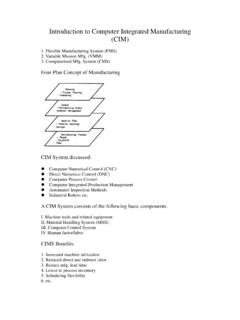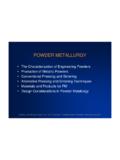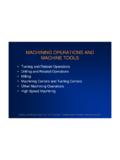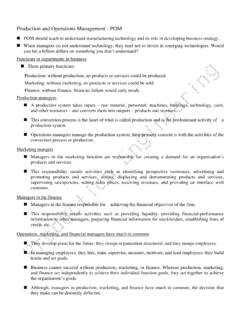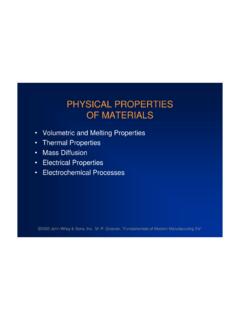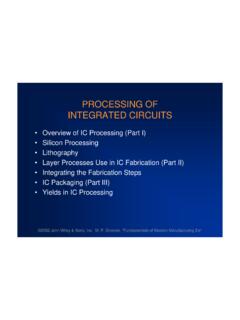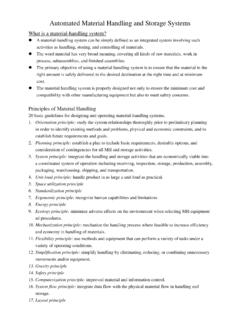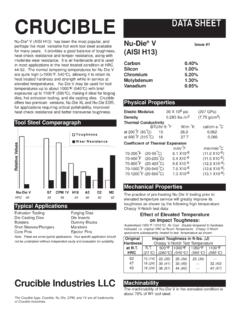Transcription of RUBBER PROCESSING TECHNOLOGY
1 2002 John Wiley & Sons, Inc. M. P. Groover, Fundamentals of Modern Manufacturing 2/e RUBBER PROCESSING TECHNOLOGY RUBBER PROCESSING and Shaping Manufacture of Tires and Other RUBBER Products Product Design Considerations 2002 John Wiley & Sons, Inc. M. P. Groover, Fundamentals of Modern Manufacturing 2/e Overview ofRubber PROCESSING and Products Many of the production methods used for plastics arealso applicable to rubbers However, RUBBER PROCESSING TECHNOLOGY is different incertain respects, and the RUBBER industry is largelyseparate from the plastics industry The RUBBER industry and goods made of RUBBER aredominated by one product:tires Tires are used in large numbers on automobiles,trucks, aircraft, and bicycles 2002 John Wiley & Sons, Inc.
2 M. P. Groover, Fundamentals of Modern Manufacturing 2/e RUBBER PROCESSING and Shaping Production of RUBBER goods consists of two of the RUBBER itself Natural RUBBER is an agricultural crop Synthetic rubbers are made from into finished goods, consisting of:(a) Compounding(b) Mixing(c) Shaping(d) Vulcanizing 2002 John Wiley & Sons, Inc. M. P. Groover, Fundamentals of Modern Manufacturing 2/e The RUBBER Industries Production of raw NR might be classified as anagricultural industry becauselatex, the startingingredient, is grown on plantations in tropical climates By contrast, synthetic rubbers are produced by thepetrochemical industry Finally, PROCESSING into tires and other productsoccurs at processor (fabricator) plants, commonlyknown as the RUBBER industry The company names include Goodyear, B.
3 , and Michelin, all reflecting theimportance of the tire 2002 John Wiley & Sons, Inc. M. P. Groover, Fundamentals of Modern Manufacturing 2/e Production of Natural RUBBER Natural RUBBER is tapped from RUBBER trees (Heveabrasiliensis) as latex The trees are grown on plantations in SoutheastAsia and other parts of the world Latex is a colloidal dispersion of solid particles of thepolymerpolyisoprenein water Polyisoprene (C5H8)nis the chemical substancethat comprises RUBBER , and its content in theemulsion is about 30% The latex is collected in large tanks, thus blending theyield of many trees together 2002 John Wiley & Sons, Inc. M. P. Groover, Fundamentals of Modern Manufacturing 2/e Recovering the RUBBER The preferred method of recovering RUBBER from latexinvolves coagulation-adding an acid such as formicacid (HCOOH); coagulation takes about 12 hours The coagulum, now soft solid slabs, is then squeezedthrough a series of rolls which drive out most of thewater and reduce thickness to about 3 mm (1/8 in) The sheets are then draped over wooden frames anddried in smokehouses Several days are normally required to completethe drying process 2002 John Wiley & Sons, Inc.
4 M. P. Groover, Fundamentals of Modern Manufacturing 2/e Grades of Natural RUBBER The resulting RUBBER , now in a form calledribbedsmoked sheet, is folded into large bales for shipmentto the processor It has a characteristic dark brown color In some cases, the sheets are dried in hot air ratherthan smokehouses, and the termair-dried sheetisused; this is considered to be a better grade of RUBBER A still better grade, calledpale creperubber, involvestwo coagulation steps, followed by warm air drying Its color is light tan 2002 John Wiley & Sons, Inc. M. P. Groover, Fundamentals of Modern Manufacturing 2/e Synthetic RUBBER Most synthetic rubbers are produced from petroleumby the same polymerization techniques used tosynthesize other polymers Unlike thermoplastic and thermosetting polymers,which are normally supplied to the fabricator aspellets or liquid resins, synthetic rubbers are suppliedto RUBBER processors in the form of large bales The RUBBER industry has a long tradition ofhandling NR in these unit loads 2002 John Wiley & Sons, Inc.
5 M. P. Groover, Fundamentals of Modern Manufacturing 2/e Compounding RUBBER is always compounded with additives Compounding adds chemicals for vulcanization,such as sulfur Additives include fillers which act either toenhance the RUBBER 's mechanical properties(reinforcing fillers) or to extend the RUBBER toreduce cost (non-reinforcing fillers) It is through compounding that the specific rubberis designed to satisfy a given application in termsof properties, cost, andprocessability 2002 John Wiley & Sons, Inc. M. P. Groover, Fundamentals of Modern Manufacturing 2/e Carbon Black in RUBBER The single most important reinforcing filler in rubberiscarbon black, a colloidal form of carbon, obtainedby thermal decomposition of hydrocarbons (soot) Its effect is to increase tensile strength andresistance to abrasion and tearing of the finalrubber product Carbon black also provides protection fromultraviolet radiation Most RUBBER parts are black in color because oftheir carbon black content 2002 John Wiley & Sons, Inc.
6 M. P. Groover, Fundamentals of Modern Manufacturing 2/e Other Fillers and Additives in RUBBER China clays-hydrous aluminum silicates(Al2Si2O5(OH)4) provide less reinforcing than carbonblack but are used when black is not acceptable Other polymers, such as styrene, PVC, and phenolics Recycled RUBBER added in some RUBBER products, butusually 10% or less Antioxidants; fatigue-and ozone-protective chemicals;coloring pigments; plasticizers and softening oils;blowing agents in the production of foamed RUBBER ;and mold release compounds 2002 John Wiley & Sons, Inc. M. P. Groover, Fundamentals of Modern Manufacturing 2/e Mixing The additives must be thoroughly mixed with thebase RUBBER to achieve uniform dispersion ofingredients Uncured rubbers have high viscosity so mechanicalworking of the RUBBER can increase its temperature upto 150 C (300 F) If vulcanizing agents were present from the start ofmixing, premature vulcanization would result-the RUBBER processor's nightmare 2002 John Wiley & Sons, Inc.
7 M. P. Groover, Fundamentals of Modern Manufacturing 2/e Two-Stage Mixing To avoid premature vulcanization, a two-stage mixingprocess is usually employedStage 1-carbon black and other non-vulcanizingadditives are combined with the raw RUBBER The termmasterbatchis used for thisfirst-stage mixtureStage 2-after stage 1 mixing has been completed,and time for cooling has been allowed, stage 2mixing is carried out in which vulcanizing agentsare added 2002 John Wiley & Sons, Inc. M. P. Groover, Fundamentals of Modern Manufacturing 2/e Filament Reinforcement in RubberProducts Many products require filament reinforcement toreduce extensibility but retain the other desirableproperties of RUBBER Examples: tires, conveyor belts Filaments used for this purpose include cellulose,nylon, and polyester Fiber-glass and steel are also used ( ,steel-belted radial tires) Continuous fiber materials must be added duringshaping; they are not mixed like the otheradditives 2002 John Wiley & Sons, Inc.
8 M. P. Groover, Fundamentals of Modern Manufacturing 2/e Shaping and Related Processes Shaping processes for RUBBER products can bedivided into four basic and casting Some products require several basic processes plusassembly work Example: tires 2002 John Wiley & Sons, Inc. M. P. Groover, Fundamentals of Modern Manufacturing 2/e Extrusion Screw extruders are generally used for extrusion ofrubber The L/D ratio of the extruder barrel is less than forthermoplastics, typically in the range 10 to 15, toreduce the risk of premature cross-linking Die swell occurs in rubberextrudates, since thepolymer is in a highly plastic condition and exhibitsthe memory property The RUBBER has not yet been vulcanized 2002 John Wiley & Sons, Inc. M. P.
9 Groover, Fundamentals of Modern Manufacturing 2/e CalenderingStock is passed through a series of gaps of decreasingsize made by a stand of rotating rolls. RUBBER sheet thickness determined by final roll gapFigure Calendering 2002 John Wiley & Sons, Inc. M. P. Groover, Fundamentals of Modern Manufacturing 2/e Roller Die ProcessCombination of extrusion and calendering that results inbetter quality product than either extrusion orcalendering aloneFigure die process- RUBBER extrusion followed by rolling 2002 John Wiley & Sons, Inc. M. P. Groover, Fundamentals of Modern Manufacturing 2/e Coating or Impregnating Fabrics with RUBBER An important industrial process for producingautomobile tires, conveyor belts, inflatable rafts, andwaterproof cloth tents and rain coatsFigure of fabric with RUBBER using a calendering process 2002 John Wiley & Sons, Inc.
10 M. P. Groover, Fundamentals of Modern Manufacturing 2/e Molded RUBBER Products Molded RUBBER products include shoe soles and heals,gaskets and seals, suction cups, and bottle stops Also, many foamed RUBBER parts are produced bymolding In addition, molding is an important process in tireproduction 2002 John Wiley & Sons, Inc. M. P. Groover, Fundamentals of Modern Manufacturing 2/e Molding Processes for RUBBER Principal molding processes for RUBBER are: (1)compression molding, (2) transfer molding, and (3)injection molding Compression molding is the most importanttechnique because of its use in tire manufacture Curing (vulcanizing) is accomplished in the mold in allthree processes, this representing a departure fromthe previous shaping methods, all of which use aseparate vulcanizing step 2002 John Wiley & Sons, Inc.
